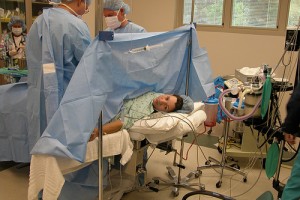March of Dimes & Recent Research Focus On Ending The Dangerous C-Section Trend
 |
When western medicine began evolving with safer surgeries and readily available "advanced" pharmaceuticals to treat disease, doctors grabbed hold and the practices of traditional medicines and midwifery became obsolete during formal medical training. These days if a baby is presenting in a "breech position" during birth, (feet or buttocks first) the general consensus among doctors is to do a cesarean surgery. But even more perturbing, women and doctors opt to perform cesareans for convenience.
Most midwives would tell you this is a dangerous and unnecessary procedure in non-emergency and breech situations. Cesareans will not only hamper recovery after labor, but also breastfeeding and the ability to deliver vaginally in the future. They also place the mother's life at greater risk. The March of Dimes (MOD) is encouraging women to choose natural births instead of scheduled C-sections. While Health Freedoms does not support all of the MOD's endorsements (such as encouraging pregnant women to get flu vaccinations), we certainly support their thumbs-down to planned cesareans for non-medical reasons.
The March of Dimes website offers tips on how to approach your doctor if he suggests a planned cesarean. The organization is bringing focus to the importance of allowing a full 39 weeks of development for a healthy baby. The last few weeks of pregnancy are especially important as an early delivery can result in hearing, vision, and eating difficulties for the baby.
It’s time to get back to letting nature take it’s course. Cesareans may offer convenience for the doctor, and some women may see them as a way to avoid labor pains, but it’s a gamble. Even in breech situations that make delivery more difficult, vaginal birth is still the safer option. Tel Aviv University researchers show evidence that C-sections are not the best way to deliver most babies in breech position.
Breech babies are not uncommon. About 4 percent of babies are in this pre-birth position and are delivered via cesarean, which as this research shows is in no way the safer solution. What makes C-Section the go-to method of delivery is the simple fact that it is much easier for the doctor to use surgery than to handle the challenges of a breech vaginal delivery. The surgery costs more too, in terms of money and recovery time, allowing the hospital to generate more profit.
A documentary, “The Business of Being Born”, delves into the overuse of cesarean and drugged births and offers informative and compelling evidence as to why the United States has the second worst newborn death rate in the developed world.
Marek Glezerman of Tel Aviv University says, “We are trying to unite obstetricians and midwives in the field to revive vaginal delivery for breech presentations. The skill has disappeared. Residents are no longer taught these techniques, and senior physicians are doing it less and less. We need to go back to the future and relearn what has been forgotten.”
~Health Freedoms
About 4 percent of babies about to be born are in the “breech position” — meaning their feet or buttocks are positioned to be delivered first instead of their heads. Mainstream medicine has long seen this as a virtually mandatory reason to use an operation known as a Caesarian section (C-section) for breech births which involves, literally, cutting the mother open to remove the infant. In fact, after a large international study published in 2000 emphasized surgery was the most cautious approach to breech births, C-sections soon became the “only way” for those deliveries in hospitals.
But now Tel Aviv University researchers have come up with evidence C-sections are not the best way to deliver most babies in breech position. Recent studies by scientists including Marek Glezerman of Tel Aviv University’s Sackler Faculty of Medicine and the Rabin Medical Center which have been published in major obstetric journals world-wide were just presented at the Canadian Congress on Breech Delivery. The conclusions? Not only are breech babies generally at no more at risk during vaginal delivery than if delivered by C-section, but natural vaginal delivery is far safer for mothers.
Glezerman emphasized at the Canadian meeting that a C-section is not simply another method of delivering a baby. It is a major surgical procedure that carries with it some potentially life threatening risks; it also decreases the chances a woman can breastfeed. What’s more, having a C-section also increases risks for women when they become pregnant again in the future. That’s because once a woman has delivered by C-section, it becomes more dangerous and occasionally impossible to deliver vaginally because the Caesarian section surgery raises the risk uterine walls and muscles could rupture during birth.
It is much easier for a doctor to perform a C-section than to deliver a breech baby vaginally — and, of course, in some emergency situations a C-section is justified. But Glezerman pointed out in a press statement that many women can benefit medically by the return to traditional techniques of safely and naturally birthing breech babies.
“We are trying to unite obstetricians and midwives in the field to revive vaginal delivery for breech presentations,” he stated. “The skill has disappeared. Residents are no longer taught these techniques, and senior physicians are doing it less and less. We need to go back to the future and relearn what has been forgotten.”
Glezerman is campaigning worldwide for doctors to return to skilled vaginal delivery of breech babies and, to that end, he has founded workshops at the Rabin Medical Center in Israel to teach the newest generation of gynecologists and obstetricians techniques for vaginal delivery of breech babies. His courses include the critically important delivery techniques of breech delivery, which include changing presentation from breech to head and management of different breech presentations.
By: S.L. Baker
http://www.naturalnews.com/030388_breech_babies_C-sections.html